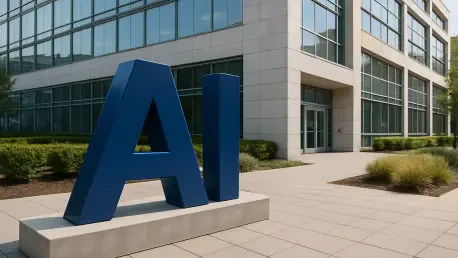Setting the Stage for AI’s Impact on Community Banking
In an era where cybersecurity threats loom large over financial institutions, community banks face a pivotal moment with the rise of artificial intelligence (AI). Recent industry surveys reveal that cybersecurity remains the top concern for these smaller banks, closely followed by the escalating costs of technology adoption. This dynamic creates a pressing need to explore how AI can reshape the market for community banking, offering both unprecedented opportunities and significant risks. The following analysis delves into current trends, data-driven insights, and future projections to understand AI’s role in leveling the playing field for smaller institutions. By examining economic impacts, technological advancements, and emerging threats, this discussion aims to equip stakeholders with a clear perspective on navigating this evolving landscape.
Market Trends and In-Depth Analysis of AI in Community Banking
AI as a Game-Changer for Fraud Detection Accessibility
One of the most transformative trends in the community banking sector is the increasing affordability of AI-driven fraud detection tools. Historically, smaller banks have struggled to compete with larger institutions due to the high costs of sophisticated automated systems. However, the rapid expansion of AI capabilities and the growing number of firms offering tailored services have driven down expenses significantly. This democratization allows community banks to adopt advanced security measures, protecting customers without straining limited budgets. Data suggests that adoption rates for such technologies among smaller institutions have surged in recent years, reflecting a market shift toward accessible innovation.
The implications of this trend are profound, as enhanced fraud detection not only bolsters trust but also reduces financial losses from scams. Yet, challenges persist in ensuring staff are adequately trained to leverage these tools effectively. Additionally, the fast pace of technological updates requires ongoing investment to stay ahead of increasingly sophisticated fraudsters. Market projections indicate that over the next few years, from 2025 to 2027, the cost of AI-based security solutions will continue to decline, further widening access for community banks. This trajectory suggests a competitive edge for those who act swiftly to integrate these systems.
Economic Opportunities from AI Infrastructure Growth
Another critical market dynamic is the economic potential tied to AI infrastructure investments, particularly in rural areas where many community banks operate. Large-scale projects like data centers, often located in regions with lower electricity costs, are spurring local growth by creating jobs and attracting tech-related industries. This development presents new lending opportunities for community banks, enabling them to support emerging businesses and diversify revenue streams. Industry analysis highlights that rural communities could see a measurable boost in productivity, with ripple effects benefiting local financial institutions.
However, this growth is not without risks, as economic disruption looms for areas heavily dependent on industries vulnerable to AI-driven automation. Community banks must strategically position themselves to mitigate potential downturns by focusing on sectors poised for expansion. Forecasts suggest that AI infrastructure projects will continue to reshape rural markets over the coming years, with investment in such initiatives expected to grow steadily. This trend underscores the importance of adaptability for banks aiming to capitalize on these economic shifts while safeguarding against associated uncertainties.
Escalating Cyber Threats in the Age of Generative AI
A darker side of AI’s market impact emerges with the rising threat of cybercrimes, particularly deepfake attacks enabled by generative technologies. Reports indicate that cybercrimes cost the global economy a staggering 10% of its gross domestic product, with deepfake incidents showing exponential growth in frequency. These attacks, which use AI to replicate voices or images, deceive victims into fraudulent actions, posing unique risks to financial institutions and their clients. The accessibility of such tools to criminals has broadened the threat landscape, making it a critical concern for community banks.
Countermeasures are becoming a focal point in market discussions, with technologies like facial recognition and voice analysis gaining traction as tools to detect inconsistencies in AI-generated content. Projections for the near term point to an increased demand for advanced security solutions, as banks race to stay ahead of evolving threats. The market for cybersecurity innovations tailored to smaller institutions is expected to expand rapidly, driven by the urgent need to protect against sophisticated scams. Community banks that invest in these defenses will likely gain a competitive advantage in maintaining customer confidence.
The Enduring Value of Relationship Banking Amid Tech Shifts
Amid the technological upheaval, the market continues to affirm the unique strength of relationship banking for community institutions. The personal knowledge bankers hold about their customers—often referred to as “soft information”—enables credit decisions that go beyond mere data points, setting smaller banks apart from larger competitors. This personal touch not only fosters trust but also enhances fraud prevention by allowing bankers to spot unusual behavior more effectively. Market trends show that customers still value these connections, even as digital banking grows.
Looking ahead, the interplay between AI adoption and relationship banking will shape market dynamics significantly. Community banks that balance technological innovation with their inherent community focus are projected to retain a loyal customer base. Data suggests that maintaining this human element could serve as a differentiator in an increasingly automated financial sector. As the market evolves, blending personal engagement with cost-effective tech solutions will be key to sustaining growth and relevance for these institutions.
Reflecting on AI’s Dual Narrative in Community Banking
Looking back, the analysis of AI’s role in community banking reveals a landscape marked by both promise and peril. The affordability of fraud detection tools opened new doors for smaller institutions, while AI infrastructure investments sparked economic potential in underserved regions. At the same time, the surge in deepfake cyber threats underscored the urgent need for robust defenses, and the enduring strength of relationship banking emerged as a vital asset. These insights point to a market at a crossroads, where strategic adaptation is paramount. Moving forward, community banks are encouraged to prioritize partnerships with reliable tech providers to enhance security, explore lending opportunities tied to AI-driven growth, and invest in advanced countermeasures against emerging risks. By leveraging their unique community ties alongside innovation, these institutions can position themselves to thrive in a rapidly changing digital era, turning challenges into stepping stones for long-term success.









